Themed collection Editor’s Choice: Solid-state ion conductors

Solid oxide proton conductors beyond perovskites
Solid oxide proton conductors have application in hydrogen-based energy technologies. This perspective presents an overview of the structural and mechanistic aspects of proton conduction in oxide systems outside conventional perovskite conductors.

J. Mater. Chem. A, 2021,9, 18836-18856
https://doi.org/10.1039/D1TA03499E
Interface modification of NASICON-type Li-ion conducting ceramic electrolytes: a critical evaluation
This review article focuses on the methods to solve the critical issue of reduction in NASICON-type solid electrolytes such as Li1+xAlxTi2−x(PO4)3 and Li1+xAlxGe2−x(PO4)3 by Li metal.
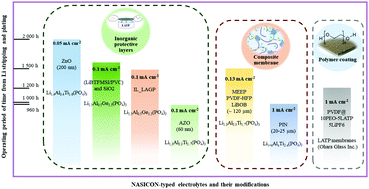
Mater. Adv., 2022,3, 3055-3069
https://doi.org/10.1039/D1MA01239H
History and recent developments in divergent electrolytes towards high-efficiency lithium–sulfur batteries – a review
Lithium–sulfur batteries, with a high specific capacity, low cost and environmental friendliness, could be investigated as a next-generation energy-storage system.

Mater. Adv., 2021,2, 4115-4139
https://doi.org/10.1039/D1MA00332A
Recent advances in layered Ln2NiO4+δ nickelates: fundamentals and prospects of their applications in protonic ceramic fuel and electrolysis cells
The review represents a comprehensive and critical analysis of the state-of-the-art knowledge on layered Ruddlesden–Popper nickelates as promising electrodes for protonic ceramic electrochemical cells.
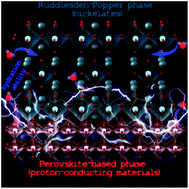
J. Mater. Chem. A, 2021,9, 154-195
https://doi.org/10.1039/D0TA08132A
A materials perspective on magnesium-ion-based solid-state electrolytes
As economically viable alternatives to lithium-ion batteries, magnesium-ion-based all-solid-state batteries have been researched to meet the criteria for an ideal energy storage device.
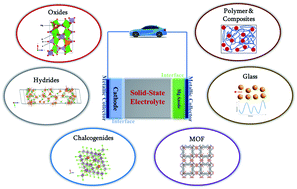
J. Mater. Chem. A, 2020,8, 2875-2897
https://doi.org/10.1039/C9TA11729F
Inorganic sulfide solid electrolytes for all-solid-state lithium secondary batteries
This review provides essential features of sulfide solid electrolytes and an in-depth explanation of the interface issues in all-solid-state lithium secondary batteries.
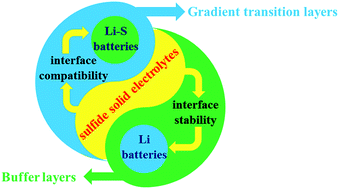
J. Mater. Chem. A, 2019,7, 20540-20557
https://doi.org/10.1039/C9TA04555D
Thin film oxide-ion conducting electrolyte for near room temperature applications
Stabilized bismuth vanadate thin films are presented here as superior oxide ionic conductors, for application in solid state electrochemical devices operating near room temperature.
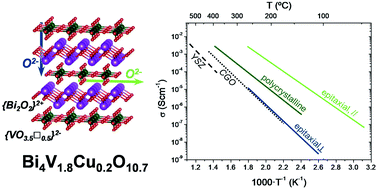
J. Mater. Chem. A, 2019,7, 25772-25778
https://doi.org/10.1039/C9TA07632H
Optimising oxygen diffusion in non-cubic, non-dilute perovskite oxides based on BiFeO3
Through molecular-dynamics simulations of rhombohedral BiFeO3, substituent cations were identified that could optimize the oxygen diffusivity and the limits of the standard crystal-chemical approach were revealed.
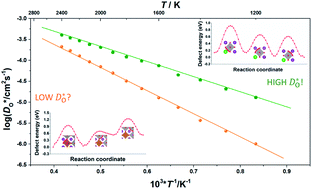
J. Mater. Chem. A, 2019,7, 25274-25278
https://doi.org/10.1039/C9TA08980B
Na+ diffusion mechanism and transition metal substitution in tunnel-type manganese-based oxides for Na-ion rechargeable batteries
Structural, computational and electrochemical investigations are combined to study the intercalation properties of tunnel-type Na0.44MnO2 and Cu-substituted Na0.44MnO2.
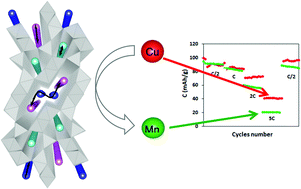
Mater. Adv., 2022,3, 986-997
https://doi.org/10.1039/D1MA00901J
Molecular dynamics investigation of the structural and energetic properties of CeO2–MOx (M = Gd, La, Ce, Zr) nanoparticles
CeO2-based materials have played a critical role in catalysis, where the substrate particles have reduced in size year by year due to experimental achievements in synthesis control.

Mater. Adv., 2021,2, 7759-7772
https://doi.org/10.1039/D1MA00543J
Excellent kinetics of single-phase Gd-doped ceria fuel electrodes in solid oxide cells
Solid oxide fuel electrodes with pure GDC as the functional layer exhibit excellent kinetics, in line with mechanistic impedance modelling.

Mater. Adv., 2021,2, 5422-5431
https://doi.org/10.1039/D1MA00202C
Correlated Li-ion migration in the superionic conductor Li10GeP2S12
A combination of single-crystal neutron diffraction experiments at low temperature and first-principles calculations revealed that a correlated migration of the densely packed Li ions governs the overall Li-ion conduction in Li10GeP2S12.
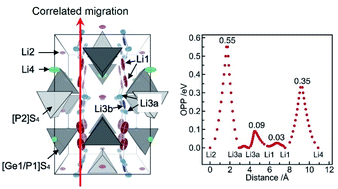
J. Mater. Chem. A, 2021,9, 11278-11284
https://doi.org/10.1039/D1TA00552A
From insulator to oxide-ion conductor by a synergistic effect from defect chemistry and microstructure: acceptor-doped Bi-excess sodium bismuth titanate Na0.5Bi0.51TiO3.015
Low levels of acceptor-type dopants can introduce appreciable levels of oxide-ion conductivity into NB0.51T due to a synergistic effect from defect chemistry and ceramic microstructure.
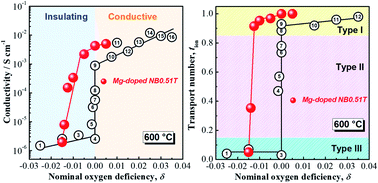
J. Mater. Chem. A, 2020,8, 25120-25130
https://doi.org/10.1039/D0TA10071D
An innovative approach to design SOFC air electrode materials: high entropy La1−xSrx(Co,Cr,Fe,Mn,Ni)O3−δ (x = 0, 0.1, 0.2, 0.3) perovskites synthesized by the sol–gel method
For the first time, the high entropy perovskites from La1−xSrx(Co,Cr,Fe,Mn,Ni)O3−δ (x = 0, 0.1, 0.2, 0.3, 0.4 and 0.5) series are documented to possess attractive properties as a candidate air electrode material for Solid Oxide Fuel Cells (SOFCs).
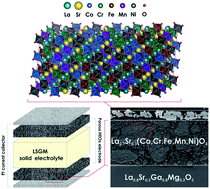
J. Mater. Chem. A, 2020,8, 24455-24468
https://doi.org/10.1039/D0TA06356H
The relationship between oxide-ion conductivity and cation vacancy order in the hybrid hexagonal perovskite Ba3VWO8.5
Cation ordering in Ba3VWO8.5 disrupts long-range oxygen diffusivity parallel to the c-axis resulting in reduced ionic conductivity.

J. Mater. Chem. A, 2020,8, 16506-16514
https://doi.org/10.1039/D0TA05581F
Electrochemical and compositional characterization of solid interphase layers in an interface-modified solid-state Li–sulfur battery
Formation of nano-sized interphase layers, containing organic and inorganic species, in an interface modified Li–sulfur solid-state battery.
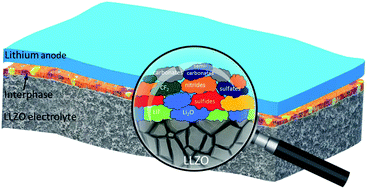
J. Mater. Chem. A, 2020,8, 16451-16462
https://doi.org/10.1039/D0TA05014H
Understanding of A-site deficiency in layered perovskites: promotion of dual reaction kinetics for water oxidation and oxygen reduction in protonic ceramic electrochemical cells
An A-site deficient layered perovskite PBCC95 is developed as a new oxygen electrode incorporated into a protonic ceramic electrochemical cell. The cell presents superior electrochemical performances and it can reversibly work between the electrolysis and fuel cell mode.
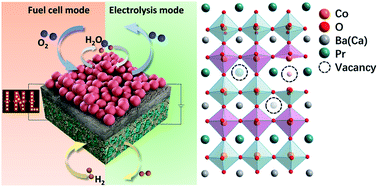
J. Mater. Chem. A, 2020,8, 14600-14608
https://doi.org/10.1039/D0TA05137C
First-principles study of superionic Na9+xSnxM3−xS12 (M = P, Sb)
Among the Na9+xSnxM3−xS12 fast Na-ion conductors Na11Sn2MS12 (M = P, Sb) is thermodynamically preferred and due to a quenchable PS4 anion order–disorder transition its ion transport properties are controlled by the thermal history of the sample.
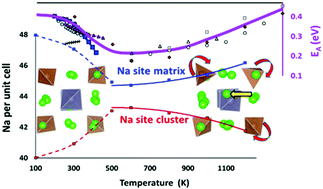
Mater. Adv., 2020,1, 184-196
https://doi.org/10.1039/D0MA00177E
Pr2BaNiMnO7−δ double-layered Ruddlesden–Popper perovskite oxides as efficient cathode electrocatalysts for low temperature proton conducting solid oxide fuel cells
The performance of low-temperature solid-oxide fuel cells (LT-SOFCs) is heavily dependent on the electrocatalytic activity of the cathode toward the oxygen reduction reaction (ORR).
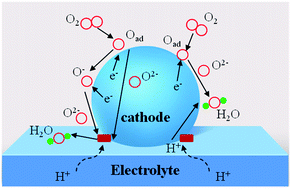
J. Mater. Chem. A, 2020,8, 7704-7712
https://doi.org/10.1039/C9TA11212J
Defect chemistry of disordered solid-state electrolyte Li10GeP2S12
Most solid-state electrolytes exhibit significant structural disorder, which requires careful consideration when modeling the defect energetics. Here, we model the native defect chemistry of a disordered solid electrolyte, Li10GeP2S12.
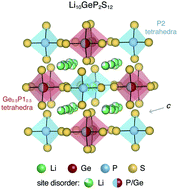
J. Mater. Chem. A, 2020,8, 3851-3858
https://doi.org/10.1039/C9TA10964A
Oriented porous LLZO 3D structures obtained by freeze casting for battery applications
A novel freeze casting technique was employed to obtain 3D porous LLZO solid-electrolyte scaffolds that were infiltrated with NMC-622 cathode material to form thick composite electrodes for all-solid-state batteries.
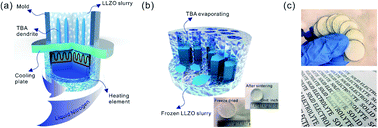
J. Mater. Chem. A, 2019,7, 20861-20870
https://doi.org/10.1039/C9TA06520B
Rationalizing the interphase stability of Li|doped-Li7La3Zr2O12via automated reaction screening and machine learning
Lithium metal batteries are a promising candidate for future high-energy-density energy storage.
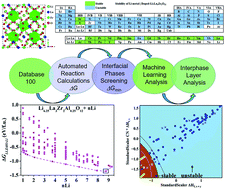
J. Mater. Chem. A, 2019,7, 19961-19969
https://doi.org/10.1039/C9TA06748E
An efficient multi-doping strategy to enhance Li-ion conductivity in the garnet-type solid electrolyte Li7La3Zr2O12
A systematic multi-doping strategy to enhance Li-ion conductivity of the garnet-type Li7La3Zr2O12 by doping Ga(III) Ba(II) and Ta(V) ions into the garnet framework.
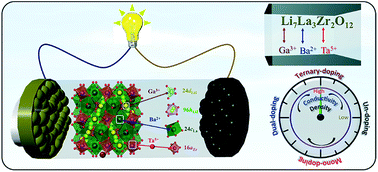
J. Mater. Chem. A, 2019,7, 8589-8601
https://doi.org/10.1039/C9TA00417C
Room temperature demonstration of a sodium superionic conductor with grain conductivity in excess of 0.01 S cm−1 and its primary applications in symmetric battery cells
The lack of suitable candidate electrolyte materials for practical application limits the development of all-solid-state Na-ion batteries.
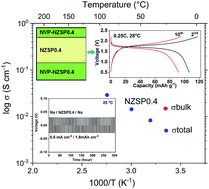
J. Mater. Chem. A, 2019,7, 7766-7776
https://doi.org/10.1039/C9TA00048H
Correlating lattice distortions, ion migration barriers, and stability in solid electrolytes
Strong correlations are observed between lattice distortions, thermodynamic stability, and limiting barriers for percolating ion migration in solid electrolytes.
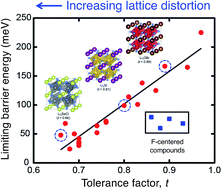
J. Mater. Chem. A, 2019,7, 3216-3227
https://doi.org/10.1039/C8TA10989C
About this collection
The newly appointed Journal of Materials Chemistry A and Materials Advances Advisory Board member, Stephen Skinner (Imperial College London, UK) who has recently come to the end of his time as an Associate Editor, has gathered the journals’ most outstanding recent papers in solid-state ion conductors for this Editor’s Choice collection.
This Editor’s Choice collection highlights recent advances in the area of ion conduction, particularly as applied to energy storage and conversion. It is evident that there continues to be significant advances in the area of lithium battery technologies, but that increasingly there is considerable activity beyond lithium technologies, including sodium, magnesium and potassium conduction. In energy conversion there is continued interest in solid oxide technologies, but with focus on using these materials in hydrogen production, through electrolysis, as well as in developing lower temperature technologies by focusing on solid proton conductors and the development of thin film devices.
This online collection brings together both experimental and simulation studies, as well as review articles covering the breadth of the topic, highlighting the diversity of work within this broad field. We hope you enjoy reading this collection.